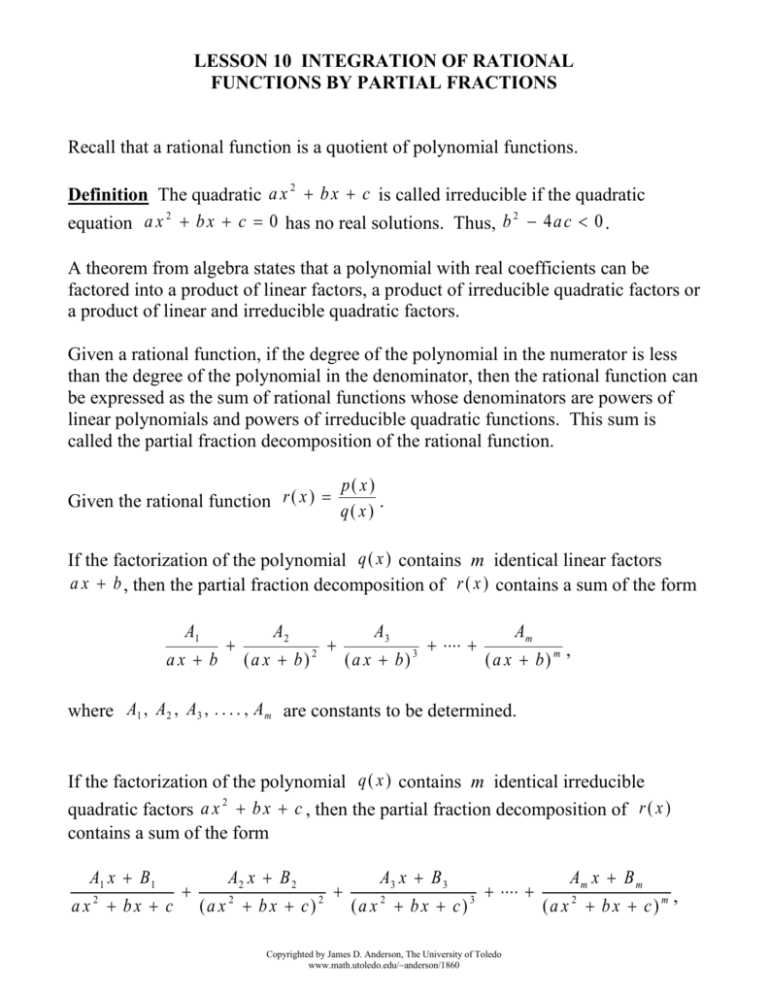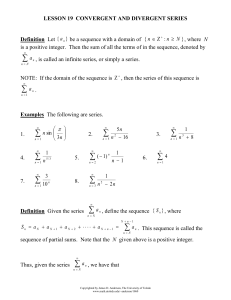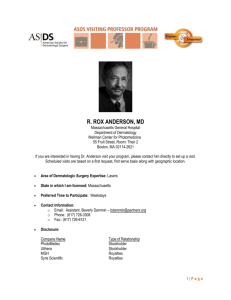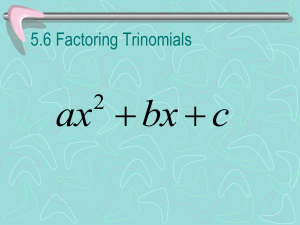Lesson 10 - The University of Toledo
advertisement

LESSON 10 INTEGRATION OF RATIONAL FUNCTIONS BY PARTIAL FRACTIONS Recall that a rational function is a quotient of polynomial functions. 2 Definition The quadratic a x b x c is called irreducible if the quadratic 2 2 equation a x b x c 0 has no real solutions. Thus, b 4 a c 0 . A theorem from algebra states that a polynomial with real coefficients can be factored into a product of linear factors, a product of irreducible quadratic factors or a product of linear and irreducible quadratic factors. Given a rational function, if the degree of the polynomial in the numerator is less than the degree of the polynomial in the denominator, then the rational function can be expressed as the sum of rational functions whose denominators are powers of linear polynomials and powers of irreducible quadratic functions. This sum is called the partial fraction decomposition of the rational function. p( x) . q( x ) Given the rational function r ( x ) If the factorization of the polynomial q ( x ) contains m identical linear factors a x b , then the partial fraction decomposition of r ( x ) contains a sum of the form A1 ax b A2 (a x b) 2 A3 (a x b) 3 Am (a x b) m , where A1 , A 2 , A3 , . . . . , A m are constants to be determined. If the factorization of the polynomial q ( x ) contains m identical irreducible 2 quadratic factors a x b x c , then the partial fraction decomposition of r ( x ) contains a sum of the form A1 x B 1 ax2 bx c A2 x B 2 (a x 2 b x c) 2 A3 x B 3 (a x 2 b x c)3 Copyrighted by James D. Anderson, The University of Toledo www.math.utoledo.edu/~anderson/1860 Am x B m (a x 2 b x c) m , where A1 , A 2 , A3 , . . . . , A m and B 1 , B 2 , B 3 , . . . . , B m are constants to be determined. Example Find the partial fraction decomposition for the following rational expression. Do NOT solve for the constants. 4 x 3 3 x 2 5 x 12 ( 3 x 5) ( x 2 ) 3 ( x 2 4 x 6 ) ( 6 x 2 2 x 7 ) 2 B A 4 x 3 3 x 2 5 x 12 = + + x 2 3x 5 ( 3 x 5) ( x 2 ) 3 ( x 2 4 x 6 ) ( 6 x 2 2 x 7 ) 2 Ex F Gx H C D Ix J + + , 2 2 2 + 3 + 2 x 4x 6 6x 2x 7 ( x 2) ( x 2) (6 x 2 x 7) 2 where A, B, C, D, E, F, G, H, I, and J are constants to be determined. NOTE: If we were asked to integrate the rational function given by the expression on the left-hand side of the equation above, we could integrate the rational functions given by the expressions on the right-hand side of the equation. In order to integrate the rational functions with quadratic denominators, we might need to complete the square for the quadratic. Examples Evaluate the following integrals. 1. 6 dx x2 9x 6 6 A B = = . We need to solve for A and B. x( x 9) x2 9x x x 9 Multiplying both sides of the equation 6 A B = by x( x 9) x x 9 Copyrighted by James D. Anderson, The University of Toledo www.math.utoledo.edu/~anderson/1860 x ( x 9 ) , we obtain the equation 6 A ( x 9 ) B x . From here, there are two methods for solving for A and B. Method 1 The first method is to solve a system of equations obtained from equating the coefficients of the terms on each side of the equation 6 A ( x 9 ) B x . 6 A( x 9 ) B x 6 A x 9 A B x 6 ( A B ) x 9 A The coefficient of the x term on the right side of the equation 6 ( A B ) x 9 A is A B . Since there is not an x term on the left side of the equation, then its coefficient is zero. Equating the coefficients of the x terms on each side of the equation, we obtain that A B 0 . The constant term on the right side of the equation 6 ( A B ) x 9 A is 9 A . The constant term on the left side of the equation is 6. Equating the constant terms on each side of the equation, we obtain that 9 A 6 . Thus, to solve for A and B, we will solve the system of equations A B 0 and 9 A 6 . 2 The second equation gives us that A . The first equation gives us that 3 2 B A . 3 Method 2 The second method involves choosing a value for x that will leave A but will eliminate B in the equation 6 A ( x 9 ) B x and choosing a value for x that will leave B but will eliminate A. To solve for A, choose x 0 : 6 A ( 0 9 ) B ( 0 ) 6 9 A 2 A 3 To solve for B, choose x 9 : 6 A ( 9 9 ) B ( 9 ) 6 9 B B Copyrighted by James D. Anderson, The University of Toledo www.math.utoledo.edu/~anderson/1860 2 3 6 A B Thus, = = x( x 9) x x 9 6 dx = x2 9x 2 2 2 1 1 3 3 . Thus, = 3 x 9 x x x 9 2 6 dx = x( x 9) 3 1 1 x 9 x dx = 2 x 9 2 c ( ln x 9 ln x ) c = ln 3 x 3 Answer: 2. 5 1 2 x 9 ln c 3 x 4x 7 dx 3 x 16 x 12 2 2 Since 3 x 16 x 12 ( x 6 ) ( 3 x 2 ) , then the function 4x 7 2 f ( x) x is defined for all real numbers x such that 3 x 2 16 x 12 3 and x 6 . The function f is continuous on its domain of definition. Thus, the function f is continuous on the closed interval [1, 5 ] . Thus, the Fundamental Theorem of Calculus can be applied. 4x 7 3 x 2 16 x 12 dx using the technique of Partial Fraction Decomposition. Then we will apply the Fundamental Theorem of Calculus with one of these antiderivatives. We will first evaluate the integral 4x 7 A B 4x 7 = = ( x 6)(3x 2) x 6 3x 2 3 x 16 x 12 2 Multiplying both sides of the equation 4x 7 A B = ( x 6)(3x 2) x 6 3x 2 Copyrighted by James D. Anderson, The University of Toledo www.math.utoledo.edu/~anderson/1860 by ( x 6 ) ( 3 x 2 ) , we obtain the equation 4 x 7 A ( 3 x 2 ) B ( x 6 ) . Method 1 4 x 7 A( 3 x 2 ) B ( x 6 ) 4 x 7 3 A x 2 A B x 6 B 4 x 7 (3A B) x 2 A 6B Equating the coefficients of x on both sides of the equation, we obtain that 3A B 4. Equating the constant terms on both sides of the equation, we obtain that 2 A 6B 7 . 3A B 4 We can solve the system of equations 2 A 6 B 7 by the addition method. 18 A 6 B 24 Multiplying the first equation by 6, we obtain 2 A 6 B 7 20 A 17 17 A Thus, . 20 Using the first equation of 3 A B 4 to solve for B, we have that 80 51 29 B 4 3A . 20 20 20 Method 2 4 x 7 A( 3 x 2 ) B ( x 6 ) To solve for A, choose x 6 : 17 20 A A To solve for B, choose x 17 20 8 21 2 2 18 B : 3 3 3 3 3 Copyrighted by James D. Anderson, The University of Toledo www.math.utoledo.edu/~anderson/1860 29 20 29 B B 3 3 20 17 29 4x 7 A B 20 20 Thus, = = = ( x 6)(3x 2) x 6 3x 2 x 6 3x 2 1 17 29 . Thus, 20 x 6 3 x 2 3x 2 1 17 29 4x 7 dx = dx = 16 x 12 20 x 6 3 x 2 1 1 17 ln x 6 29 ln 3 x 2 c = 20 3 1 29 ln 3 x 2 c = 17 ln x 6 20 3 1 ( 51 ln x 6 29 ln 3 x 2 ) c 60 Now, that we have all the antiderivatives of the integrand 4x 7 f ( x) , we can apply the Fundamental Theorem of Calculus 2 3 x 16 x 12 5 4x 7 dx . to evaluate the definite integral 1 3 x 2 16 x 12 5 1 5 4x 7 1 dx ( 51 ln x 6 29 ln 3 x 2 ) = = 3 x 2 16 x 12 60 1 1 1 [ 51 ln 1 29 ln 17 ( 51 ln 5 29 ln 5 ) ] = ( 0 29 ln 17 80 ln 5 ) = 60 60 1 ( 29 ln 17 80 ln 5 ) 60 Copyrighted by James D. Anderson, The University of Toledo www.math.utoledo.edu/~anderson/1860 Answer: 3. 1 ( 29 ln 17 80 ln 5 ) 60 t 2 3t 2 dt 10 t 4 6 t 3 t 2 3t 2 t 2 3t 2 = . Thus, 10 t 4 6 t 3 2 t 3 ( 5t 3) 1 2 t 2 3t 2 dt = 10 t 4 6 t 3 t 2 3t 2 dt = 2 t 3 ( 5t 3) t 2 3t 2 dt t 3 ( 5t 3) t 2 3t 2 Thus, we will find the partial fraction decomposition for 3 . Thus, t ( 5t 3) A B C D t 2 3t 2 2 3 = . Multiplying both sides of this 3 t t t 5t 3 t ( 5t 3) 3 equation by t ( 5 t 3 ) , we obtain the following equation. t 2 3t 2 A t 2 ( 5 t 3 ) B t ( 5 t 3 ) C ( 5 t 3 ) D t 3 To solve for C, choose t 0 : 2 3C C 2 3 3 9 9 27 2 D To solve for D, choose t : 5 25 5 125 20 45 225 250 27 D 20 27 D D 27 In order to solve for A and B, we will need to equate coefficients. 2 3 Note that the coefficient of the t term in the product A t ( 5 t 3 ) is 5 A . The products of B t ( 5 t 3 ) and C ( 5 t 3 ) do not have a t 3 term. Thus, the 3 coefficient of the t term on the right side of the equation is 5 A D . The Copyrighted by James D. Anderson, The University of Toledo www.math.utoledo.edu/~anderson/1860 coefficient of the t 3 term on the left side of the equation is 0. Equating the coefficients of t 3 on both sides of the equation, we obtain that 5 A D 0 . 20 20 20 0 5A Since D from above, then we have that 5 A 27 27 27 4 A . 27 t 2 3t 2 A t 2 ( 5 t 3 ) B t ( 5 t 3 ) C ( 5 t 3 ) D t 3 Note that the coefficient of the t term in the product B t ( 5 t 3 ) is 3 B and the coefficient of the t term in the product C ( 5 t 3 ) is 5 C . The product of A t 2 ( 5 t 3 ) does not have a t term. Thus, the coefficient of the t term on the right side of the equation is 3 B 5 C . The coefficient of the t term on the left side of the equation is 3 . Equating the coefficients of t on both 2 sides of the equation, we obtain that 3 B 5 C 3 . Since C from 3 10 3 above, then we have that 3 B 5C 3 3B 3 1 9 B 10 9 B . 9 4 1 2 20 A B C D t 3t 2 27 9 3 27 2 3 Thus, 3 = = = t t t 5t 3 t t 2 t 3 5t 3 t ( 5t 3) 4 3 18 20 1 4 3 18 20 27 27 27 27 . Thus, = 27 t t2 t 3 5 t 3 t t2 t3 5t 3 2 1 1 t 2 3t 2 1 t 2 3t 2 dt = 3 dt = 4 3 2 27 10 t 6 t 2 t ( 5t 3) 1 54 4 3 18 20 t t 2 t 3 5t 3 dt = 4 20 dt = 3t 2 18 t 3 t 5 t 3 Copyrighted by James D. Anderson, The University of Toledo www.math.utoledo.edu/~anderson/1860 1 3t 1 18 t 2 1 4 ln t 20 ln 5 t 3 c = 54 1 2 5 1 3 9 4 ln t 2 4 ln 5 t 3 c 54 t t Answer: 4. 1 3 9 4 ln t 2 4 ln 5 t 3 c 54 t t 3x 5 dx ( x 4 ) ( 4 x 2 12 x 9 ) 2 2 NOTE: 4 x 12 x 9 ( 2 x 3 ) . Thus, 3x 5 dx = ( x 4 ) ( 4 x 2 12 x 9 ) 3x 5 dx ( x 4 ) ( 2 x 3) 2 Thus, we will find the partial fraction decomposition for 3x 5 . ( x 4 ) ( 2 x 3) 2 Thus, 3x 5 A B C = . Multiplying both sides ( x 4 ) ( 2 x 3) 2 x 4 2 x 3 ( 2 x 3) 2 2 of this equation by ( x 4 ) ( 2 x 3 ) , we obtain the following equation. 3 x 5 A( 2 x 3) 2 B ( x 4 ) ( 2 x 3) C ( x 4 ) To solve for A, choose x 4 : 7 121 A A To solve for C, choose x 19 11 C 2 2 C 7 121 3 9 10 3 8 C : 2 2 2 2 2 19 11 Copyrighted by James D. Anderson, The University of Toledo www.math.utoledo.edu/~anderson/1860 In order to solve for B, we will need to equate coefficients. 2 Note that the coefficient of the x 2 term in the product A ( 2 x 3 ) is 4 A . The coefficient of the x 2 term in the product B ( x 4 ) ( 2 x 3 ) is 2 B . The product of C ( x 4 ) does not have a x 2 term. Thus, the coefficient of the x 2 term on the right side of the equation is 4 A 2 B . The coefficient of the x 2 term on the left side of the equation is 0. Equating the coefficients of x 2 on both sides of the equation, we obtain that 4 A 2 B 0 2 A B 0 . 7 Since A from above, then we have that 2 A B 0 B 2 A = 121 14 . 121 3x 5 A B C Thus, = = ( x 4 ) ( 2 x 3) 2 x 4 2 x 3 ( 2 x 3) 2 7 14 19 7 14 209 121 121 11 121 121 121 = 2 = x 4 2 x 3 ( 2 x 3) x 4 2 x 3 ( 2 x 3) 2 1 7 14 209 121 x 4 2 x 3 ( 2 x 3 ) 2 3x 5 dx = ( x 4 ) ( 4 x 2 12 x 9 ) 1 121 1 121 . Thus, 3x 5 dx = ( x 4 ) ( 2 x 3) 2 7 14 209 2 x 4 2 x 3 ( 2 x 3) dx = 7 14 209 ( 2 x 3 ) 2 x 4 2x 3 dx = 1 1 1 ( 2 x 3) 1 7 ln x 4 14 ln 2 x 3 209 121 2 2 1 Copyrighted by James D. Anderson, The University of Toledo www.math.utoledo.edu/~anderson/1860 c = 1 209 7 ln x 4 7 ln 2 x 3 c 121 2 ( 2 x 3 ) Answer: 1 209 7 ln x 4 7 ln 2 x 3 c OR 121 2 ( 2 x 3 ) 5. 1 209 7 ln x 4 7 ln 2 x 3 c 121 2 ( 2 x 3 ) 6t 2 8t 5 dt ( t 3 ) ( 2 t 1) ( t 1) 6t 2 8t 5 We will find the partial fraction decomposition for . ( t 3 ) ( 2 t 1) ( t 1) Thus, A B C 6t 2 8t 5 = . Multiplying both sides of t 3 2t 1 t 1 ( t 3 ) ( 2 t 1) ( t 1) this equation by ( t 3 ) ( 2 t 1) ( t 1) , we obtain the following equation. 6 t 2 8 t 5 A ( 2 t 1) ( t 1) B ( t 3 ) ( t 1) C ( t 3 ) ( 2 t 1) To solve for A, choose t 3 : 54 24 5 ( 7 ) ( 4 ) A 73 28 A 73 A 28 1 3 1 6 1 2 4 5 B To solve for B, choose t : 2 2 2 2 2 2 3 18 7 1 15 7 30 B B B 2 2 2 4 7 2 2 To solve for C, choose t 1 : 6 8 5 ( 4 ) ( 1) C 7 4 C Copyrighted by James D. Anderson, The University of Toledo www.math.utoledo.edu/~anderson/1860 C 7 4 A B C 6t 2 8t 5 Thus, = = t 3 2t 1 t 1 ( t 3 ) ( 2 t 1) ( t 1) 73 30 73 120 49 7 28 7 4 28 28 28 = = t 3 2t 1 t 1 t 3 2t 1 t 1 1 73 120 49 28 t 3 2 t 1 t 1 . Thus, 1 6t 2 8t 5 dt = 28 ( t 3 ) ( 2 t 1) ( t 1) 73 120 49 t 3 2t 1 t 1 dt = 1 1 73 ln t 3 120 ln 2 t 1 49 ln t 1 c = 28 2 1 73 ln t 3 60 ln 2 t 1 49 ln t 1 28 Answer: 6. c 1 73 ln t 3 60 ln 2 t 1 49 ln t 1 28 c y 3 2 y 12 dy y 4 5 y 2 36 4 2 2 Note that y 5 y 36 is quadratic in y and we have that y 4 5 y 2 36 = ( y 2 4 ) ( y 2 9) = ( y 2 ) ( y 2 ) ( y 2 9) . Thus, y 3 2 y 12 dy = y 4 5 y 2 36 y 3 2 y 12 dy ( y 2 ) ( y 2 ) ( y 2 9) Copyrighted by James D. Anderson, The University of Toledo www.math.utoledo.edu/~anderson/1860 y 3 2 y 12 We will find the partial fraction decomposition for . ( y 2 ) ( y 2 ) ( y 2 9) Thus, A B Cy D y 3 2 y 12 = . Multiplying both y 2 y 2 y2 9 ( y 2 ) ( y 2 ) ( y 2 9) 2 sides of this equation by ( y 2 ) ( y 2 ) ( y 9) , we obtain the following equation. y 3 2 y 12 A( y 2 ) ( y 2 9) B ( y 2 ) ( y 2 9) ( C y D) ( y 2 4) 2 NOTE: ( y 2 ) ( y 2 ) y 4 To solve for A, choose y 2 : 8 4 12 ( 4 ) (13 ) A 2 8 ( 4 ) (13 ) A 2 13 A A 13 To solve for B, choose y 2 : 8 4 12 ( 4 ) (13 ) B 4 16 ( 4 ) (13 ) B 4 13 B B 13 In order to solve for C and D, we will need to equate coefficients. 2 3 Note that the coefficient of the y term in the product A ( y 2 ) ( y 9) is A . The coefficient of the y 3 term in the product B ( y 2 ) ( y 2 9) is B . 2 3 The coefficient of the y term in the product ( C y D) ( y 4) is C . Thus, 3 the coefficient of the y term on the right side of the equation is A B C . 3 The coefficient of the y term on the left side of the equation is 1 . 3 Equating the coefficients of y on both sides of the equation, we obtain that 2 4 A B C 1 . Since A and B from above, then we have 13 13 2 4 2 11 C 1 C 1 C . that 13 13 13 13 y 3 2 y 12 A( y 2 ) ( y 2 9) B ( y 2 ) ( y 2 9) ( C y D) ( y 2 4) Copyrighted by James D. Anderson, The University of Toledo www.math.utoledo.edu/~anderson/1860 2 2 Note that the coefficient of the y term in the product A ( y 2 ) ( y 9) is 2 A . The coefficient of the y 2 term in the product B ( y 2 ) ( y 2 9) is 2 B . The coefficient of the y 2 term in the product ( C y D) ( y 2 4) is D . 2 Thus, the coefficient of the y term on the right side of the equation is 2 A 2 B D . The coefficient of the y 2 term on the left side of the 2 equation is 0. Equating the coefficients of y on both sides of the equation, 2 4 we obtain that 2 A 2 B D 0 . Since A and B from 13 13 4 8 12 D 0 D . above, then we have that 13 13 13 A B Cy D y 3 2 y 12 2 Thus, = = 2 y 2 y 2 y 9 ( y 2 ) ( y 2 ) ( y 9) 2 4 11 12 y 1 2 4 11 y 12 13 13 13 13 = 2 13 y 2 y 2 y2 9 y 2 y 2 y 9 = 1 2 4 11 y 12 . Thus, 2 2 13 y 2 y 2 y 9 y 9 y 3 2 y 12 dy = y 4 5 y 2 36 1 13 y 3 2 y 12 dy = ( y 2 ) ( y 2 ) ( y 2 9) 2 4 11 y 12 2 2 y 2 y 2 y 9 y 9 dy = 1 1 1 2 1 y 2 ln y 2 4 ln y 2 11 ln ( y 9 ) 12 tan c = 13 2 3 3 1 11 2 1 y 2 ln y 2 4 ln y 2 ln ( y 9 ) 4 tan c = 13 2 3 Copyrighted by James D. Anderson, The University of Toledo www.math.utoledo.edu/~anderson/1860 1 y 2 4 2 11 / 2 4 tan 1 c = ln ( y 2 ) ln ( y 2 ) ln ( y 9 ) 13 3 1 ( y 2) 2 y ln 4 tan 1 4 2 11 / 2 13 ( y 2 ) ( y 9 ) 3 Answer: c 1 11 2 1 y 2 ln y 2 4 ln y 2 ln ( y 9 ) 4 tan c OR 13 2 3 1 ( y 2) 2 1 y ln 4 tan 13 ( y 2 ) 4 ( y 2 9 ) 11/ 2 3 7. c 3x 3 6 x 2 8 dx 9 x 4 24 x 2 16 4 2 Note that 9 x 24 x 16 is quadratic in x 2 and we have that 9 x 4 24 x 2 16 = ( 3 x 2 4 ) 2 . Thus, 3x 3 6 x 2 8 dx = 9 x 4 24 x 2 16 3x 3 6 x 2 8 dx (3x 2 4) 2 3x 3 6 x 2 8 We will find the partial fraction decomposition for . Thus, (3x 2 4) 2 Ax B Cx D 3x 3 6 x 2 8 = . Multiplying both sides of this 2 3x 4 (3x 2 4) 2 (3x 2 4) 2 2 2 equation by ( 3 x 4 ) , we obtain the following equation. 3 x 3 6 x 2 8 ( A x B ) ( 3 x 2 4) C x D If we let x 0 , we obtain the equation 8 4 B D . Copyrighted by James D. Anderson, The University of Toledo www.math.utoledo.edu/~anderson/1860 2 Note that the coefficient of the x 3 term in the product ( A x B ) ( 3 x 4) is 3 A . Thus, the coefficient of the x 3 term on the right side of the equation is 3 A . The coefficient of the x 3 term on the left side of the equation is 3. Equating the coefficients of x 3 on both sides of the equation, we obtain that 3 A 3 A 1. 3 x 3 6 x 2 8 ( A x B ) ( 3 x 2 4) C x D 2 Note that the coefficient of the x 2 term in the product ( A x B ) ( 3 x 4) is 3 B . Thus, the coefficient of the x 2 term on the right side of the equation is 3 B . The coefficient of the x 2 term on the left side of the equation is 6 . Equating the coefficients of x 2 on both sides of the equation, we obtain that 3B 6 B 2 . Since 8 4 B D from above and B 2 , then 8 8 D D 0. 2 Note that the coefficient of the x term in the product ( A x B ) ( 3 x 4) is 4 A . Thus, the coefficient of the x term on the right side of the equation is 4 A C . The coefficient of the x term on the left side of the equation is 0. Equating the coefficients of x on both sides of the equation, we obtain that 4 A C 0 . Since A 1 , then C 4 . x 2 4x 3x 3 6 x 2 8 Ax B Cx D Thus, = = = 3x 2 4 (3x 2 4) 2 3x 2 4 (3x 2 4) 2 (3x 2 4) 2 x 3x 2 4 Thus, 2 3x 2 4 4x . (3x 2 4) 2 3x 3 6 x 2 8 dx = 9 x 4 24 x 2 16 3x 3 6 x 2 8 dx = (3x 2 4) 2 x 2 4x 2 2 2 2 3x 4 3x 4 (3x 4) dx = Copyrighted by James D. Anderson, The University of Toledo www.math.utoledo.edu/~anderson/1860 x 1 2 4 x(3x 2 4) 2 2 3 x 4 3 x 2 4 3 dx = 3 x 1 2 3 1 (3x 2 4) 1 2 1 ln ( 3 x 4 ) tan 4 c = 6 3 2 2 6 1 3 3 x 1 2 ln ( 3 x 2 4 ) tan 1 c 6 3 2 3( 3 x 2 4 ) 3 3 x 1 2 2 1 ln ( 3 x 4 ) tan c Answer: 6 3 2 3( 3 x 2 4 ) Copyrighted by James D. Anderson, The University of Toledo www.math.utoledo.edu/~anderson/1860









